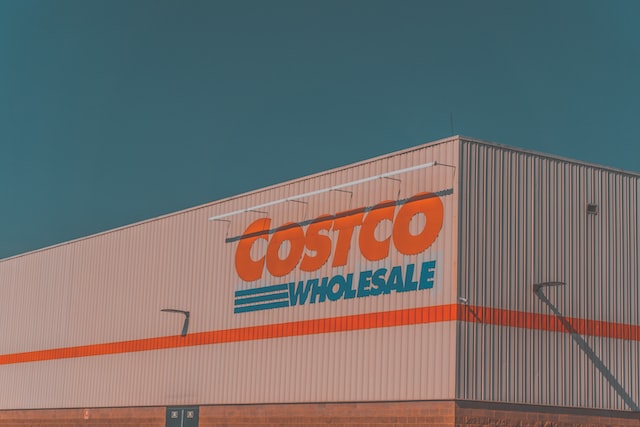Before we dive deep into the PESTEL analysis, let’s get the business overview of Costco. Costco Wholesale Corporation is an American multinational corporation that operates a chain of membership-only big-box retail stores. It’s known for selling a wide range of products, from groceries to electronics, clothing, jewelry, home furnishings, and more.
Costco was founded in 1976 under the name “Price Club” in San Diego, California. In 1983, the first Costco warehouse opened in Seattle, Washington. The two companies merged in 1993 to become PriceCostco, and later in 1997, it was renamed Costco Wholesale Corporation.
Business Model:
- Membership-Based: Costco’s primary revenue driver is its membership fees. The company offers various membership levels for individual shoppers (Gold Star) and businesses. Members benefit from reduced prices on a range of products.
- Limited Stock Keeping Units (SKUs): Unlike traditional supermarkets or stores that might stock thousands of SKUs, Costco stocks a limited number of SKUs, focusing on bulk and volume sales. This allows them to negotiate better prices from suppliers and pass the savings on to members.
- Private Label Products: Costco’s in-house brand, Kirkland Signature, is known for offering high-quality products at competitive prices. This brand is found across various product categories and has garnered a loyal following.
- Low Operating Margins: Costco is known for its commitment to keeping prices low. As a result, the company often operates on thinner margins than many competitors, relying on high-volume sales and membership fees for profitability.
Costco’s business model of Customer Exclusivity
As of 2021, Costco had hundreds of locations worldwide, with warehouses in the U.S., Canada, Mexico, the U.K., Japan, Korea, Taiwan, Australia, Spain, France, and more. The company continued to expand its global footprint.
Costco also operates an e-commerce platform in various countries, allowing members to shop online and, in some areas, avail of services like same-day grocery delivery.
Costco offers various ancillary services, including gas stations, optical dispensing centers, food courts, and travel services. These serve as additional revenue streams and a means to drive traffic to their physical warehouses.
Financial Performance 2023: Net sales for the 53-week fiscal year were $237.71 billion, an increase of 6.7 percent from $222.73 billion in the 52-week fiscal year of 2022. Net income for the 53-week fiscal year was $6.292 billion, $14.16 per diluted share, compared to $5.844 billion, $13.14 per diluted share, in the 52-week prior year.
Here is the PESTEL analysis of Costco
A PESTEL analysis is a strategic management framework used to examine the external macro-environmental factors that can impact an organization or industry. The acronym PESTEL stands for:
- Political factors: Relate to government policies, regulations, political stability, and other political forces that may impact the business environment.
- Economic factors: Deal with economic conditions and trends affecting an organization’s operations, profitability, and growth.
- Sociocultural factors: Relate to social and cultural aspects that may influence consumer preferences, lifestyles, demographics, and market trends.
- Technological factors: Deal with developing and applying new technologies, innovations, and trends that can impact an industry or organization.
- Environmental factors: Relate to ecological and environmental concerns that may affect an organization’s operations and decision-making.
- Legal factors: Refer to the laws and regulations that govern businesses and industries.
In this article, we will do a PESTEL Analysis of Costco.
PESTEL Analysis Framework: Explained with Examples
Political
- Trade and Tariff Policies: International trade policies can affect Costco, especially given its global presence. Changes in tariffs, trade wars, or import/export restrictions can increase costs for the company, which might get passed on to consumers or affect profitability.
- Regulation and Legislation: Local, state, and federal regulations, especially those related to retail, employment, health, and safety, can directly impact Costco’s operations. These might include minimum wage laws, work-hour regulations, or food safety standards.
- Political Stability: Political stability in countries where Costco operates is crucial. Unrest or abrupt political changes can disrupt their supply chain, operations, or demand patterns.
- Tax Policies: Changes in corporate tax rates, sales taxes, or VAT (in countries outside the U.S.) can affect Costco’s profitability and pricing strategies.
- Foreign Relations: Given that Costco sources products globally, diplomatic relations between the U.S. (where Costco is headquartered) and other countries can impact their sourcing strategy. A souring of relations can lead to increased costs or supply chain disruptions.
- Consumer Protection Laws: Political decisions related to consumer rights and protection can affect how Costco operates, especially regarding product returns, warranties, and the quality and safety of products sold.
- Infrastructure Development: Political decisions related to infrastructure (roads, ports, etc.) can affect Costco’s logistics and distribution efficiency. Better infrastructure can reduce costs and increase efficiency, while poor infrastructure can do the opposite.
- Economic Sanctions: Sanctions against countries can influence where Costco can expand or operate. If the U.S. places sanctions against a nation, Costco might find it challenging to source products from or operate within that country.
Economic
- Economic Growth: The state of the economy in countries where Costco operates can affect consumers’ purchasing power. Consumers tend to spend more during the economic boom, which can benefit Costco. Conversely, consumers might cut back on spending during economic downturns or look for cheaper alternatives.
- Exchange Rates: Given that Costco operates globally, fluctuations in currency exchange rates can influence its profitability. A strong U.S. dollar might make imports cheaper but can affect revenues when translated back from weaker foreign currencies.
- Inflation Rates: Inflation can impact the cost of goods sold and consumer purchasing power. Rising inflation can increase costs for Costco, which may or may not be passed onto the consumer.
- Interest Rates: Changes in interest rates can affect Costco’s financing costs. For instance, higher interest rates can increase the cost of borrowing for expansion or operations.
- Unemployment Rates: High unemployment can decrease consumer spending as disposable income reduces, which could lead to reduced sales for Costco. Conversely, low unemployment can boost consumer confidence and spending.
- Consumer Confidence: Consumers who feel optimistic about their financial future are likelier to spend on non-essential items, benefiting retailers like Costco. Conversely, low consumer confidence can lead to reduced spending.
- Fuel Prices: Given Costco’s vast logistics and supply chain operations, fuel price fluctuations can significantly impact transportation costs.
- Commodity Prices: Prices of essential commodities, whether it’s agricultural produce or metals, can influence the cost of products that Costco sells.
- Competitive Landscape: Competitors’ economic health and strategies can influence Costco’s market position. For instance, aggressive pricing or expansion by competitors during favorable economic times can pose challenges.
- Taxation Policies: Changes in taxation can influence consumer spending and corporate profitability. For example, reduced sales tax might boost consumer spending, while changes in corporate tax can affect profitability.
- Real Estate Market Conditions: Given that Costco operates large warehouse-style stores, the real estate market can decide where and when to open new stores. The cost of real estate, rental prices, and property taxes can all play a role.
Sociocultural
- Consumer Behavior: Different societies have different consumption patterns. While bulk buying and value-seeking might be popular in one region, it may not be as prevalent in another. For instance, consumers in densely populated urban areas in countries like Japan might not have the storage space for bulk items.
- Cultural Norms and Preferences: Taste preferences, lifestyle choices, and cultural norms vary by region. For example, certain foods or products popular in one country might not be in another due to cultural differences.
- Health and Wellness Trends: With growing global consciousness about health, fitness, and wellness, there’s a rising demand for organic, low-fat, and healthy products. Costco needs to ensure its product offerings align with these preferences.
- Ethical and Sustainable Consumption: There’s a growing trend of consumers seeking ethically-sourced and sustainable products. This trend means that Costco might need to adjust its sourcing practices or offer more eco-friendly products.
- Demographics: Changes in age distribution, family size, and other demographic factors can influence demand. For instance, an aging population might demand different products than a predominantly younger demographic.
- Work Culture: In regions with long work hours or more dual-income households, there might be a higher demand for convenience products, ready-to-eat meals, or delivery services.
- Value Orientation: In some cultures, value-for-money’s significantly emphasized, which plays into Costco’s primary value proposition. In others, brand prestige or other factors might be more important.
Technological
- E-commerce and Digital Platforms: The rise of online shopping platforms requires companies like Costco to ensure a solid online presence. Costco must have a robust e-commerce platform, mobile applications, and digital payment systems to cater to consumers’ changing shopping behaviors.
- Supply Chain Management Systems: Advanced technological tools and software can help streamline inventory management, distribution, and supply chain operations, making them more efficient and responsive to market demands.
- Data Analytics: Big data and advanced analytics can provide valuable insights into consumer behavior, preferences, and buying patterns. By leveraging this data, Costco can tailor its product offerings, marketing campaigns, and even store layouts.
- Digital Marketing: With the proliferation of digital media, Costco must utilize online advertising, social media marketing, and other digital marketing tools to reach its target audience effectively.
- Artificial Intelligence (A.I.) and Machine Learning: These technologies can be utilized for demand forecasting, customer service (like chatbots), and personalized marketing efforts.
- Electronic Payment Systems: With the decline of cash transactions in many regions, Costco must integrate various digital and electronic payment methods, including mobile payments, contactless payments, and online banking systems.
- Smart Retail Solutions: Technologies like IoT (Internet of Things) can be employed in-store to improve customer experiences, from smart carts that guide customers to products to automated checkout systems.
- Sustainability Technologies: As sustainability becomes a focal point, technologies that promote energy efficiency (like solar panels or efficient cooling systems) or reduce waste can be crucial for Costco’s operations.
- Augmented Reality (A.R.) and Virtual Reality (V.R.): While still emerging in the retail sector, these technologies can be used for virtual product trials or immersive shopping experiences, enhancing the e-commerce experience.
- Warehouse Automation: Robotics and automation technologies can enhance warehouse operations, making them more efficient, reducing errors, and ensuring faster processing times.
Environmental
- Sustainability Initiatives: There’s a growing global emphasis on sustainability. Costco may need to ensure sustainable sourcing, reduce its carbon footprint, and prioritize eco-friendly products to meet consumer demands and regulatory requirements.
- Waste Management: Large retailers generate significant waste, especially with packaging. How Costco manages its waste, especially by recycling or reducing single-use plastics, can impact its public perception and operational costs.
- Energy Consumption: The energy consumed in warehouses, logistics, and transportation plays into Costco’s environmental footprint. Adopting green energy solutions, like solar panels on warehouse roofs or electric vehicles for delivery, can make a difference.
- Carbon Footprint: With the emphasis on reducing greenhouse gas emissions, Costco might be pushed to measure, report, and reduce its carbon emissions across its supply chain and operations.
- Water Usage: Ensuring water conservation in its operations and promoting water-efficient products sourced from areas without water scarcity can become a consideration.
- Ethical Sourcing: Consumers are increasingly aware of where products come from. Costco might need to ensure its products are ethically sourced without causing environmental degradation or biodiversity loss.
- Local Environmental Regulations: Different countries or regions may have varying environmental regulations and standards. Compliance with these is crucial to avoid legal repercussions and maintain a positive brand image.
- Natural Disasters: Events like floods, hurricanes, or wildfires can disrupt operations, especially in areas prone to such incidents. Understanding and planning for these risks is essential for a company with a vast physical presence like Costco.
- Climate Change: Global climate change can impact supply chains, especially for agricultural products. Fluctuating weather patterns can influence crop yields and, subsequently, prices and availability of products.
Legal
- Employment Laws: Different countries have different regulations regarding minimum wage, working hours, benefits, and workplace conditions. Costco must ensure that it meets or exceeds these standards wherever it operates.
- Consumer Protection Laws: These laws regulate how businesses deal with consumers, from advertising practices to product safety standards and return policies.
- Data Protection and Privacy Laws: With the increasing digitization of retail, there are stringent laws in places like the European Union (GDPR) that mandate how companies collect, store, and use consumer data.
- Environmental Laws: Regulations regarding waste disposal, emissions, and energy consumption can impact how Costco operates its warehouses, transportation, and other aspects of its business.
- Trade and Tariff Laws: As a global entity, Costco deals with import and export regulations, and any changes in these (like trade wars or Brexit implications) can influence the company’s sourcing and pricing strategies.
- Real Estate and Zoning Laws: When establishing new warehouses or facilities, Costco needs to navigate local zoning laws, construction standards, and land use regulations.
- Taxation Laws: These vary widely by country and region and can significantly impact Costco’s profitability. They might include sales tax, VAT, corporate tax, and other local levies.
- Intellectual Property Laws: Protecting the brand, trademarks, and proprietary processes is essential for any major corporation. For Costco, ensuring it doesn’t infringe on others’ I.P. and protecting its own is crucial.
- Health and Safety Regulations: Especially relevant for a retailer, these regulations concern the safety standards of products sold, the conditions in warehouses, and the processes involved in handling food and other perishable items.
- Competition and Antitrust Laws: Given its size, Costco might sometimes come under scrutiny to ensure that it isn’t engaging in anti-competitive practices or creating monopolistic conditions in its markets.
- Licensing and Certification: Costco might need specific licenses or certifications depending on the region and the type of products sold. This is especially true for pharmaceuticals, alcohol, or organic products.
- Supplier and Vendor Contracts: The legalities surrounding contracts with suppliers and vendors, including terms of service, payment conditions, and dispute resolution, are crucial for smooth operations.











